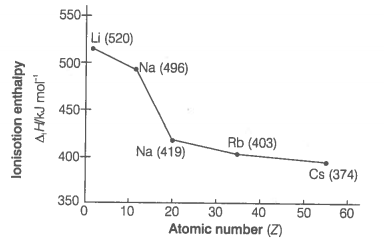Discuss and compare the trend in ionisation enthalpy of the elements of group 1 with those of group 17 elements.
|
Group 1 |
First ionization enthalpies (kJ mol-1) |
Group 17 |
First ionization enthalpies (kJ mol-1) |
|
H |
1312 |
F |
1681 |
|
Li |
520 |
Cl |
1255 |
|
Na |
496 |
Br |
1142 |
|
K |
419 |
I |
1009 |
|
Rb |
403 |
At |
917 |
|
Cs |
374 |
|
|

Given trend can be easily explained on the basis of increasing atomic size and screening effect as follows
(i) On moving down the group, the atomic size increases gradually due to the addition of one new principal energy shell at each succeeding element. Hence, the distance of the valence electrons from the nucleus increases.
Consequently, the force of attraction by the nucleus for the valence electrons decreases and hence the ionisation enthalpy should decrease.
(ii) With the addition of new shells, the shielding or the screening effect increases. As a result, the force of attraction of the nucleus for the valence electrons further decreases and hence the ionisation enthalpy should decrease.
(iii) Nuclear charge increases the increase in atomic number. As a result, the force of attraction by the nucleus for the valence electrons should increase and accordingly the ionisation enthalpy should increase.
The combined effect of the increase in the atomic size and the screening effect more than compensates the effect of the increased nuclear charges. Consequently, the valence electrons become less and less firmly held by the nucleus and hence the ionisation enthalpies gradually decrease as move down the group.

© 2025 GoodEd Technologies Pvt. Ltd.